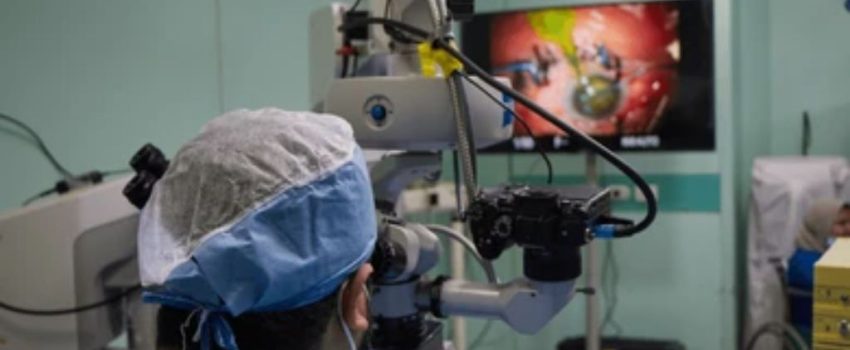If your doctor has recommended phacoemulsification, or “phaco,” it likely means you’ve been diagnosed with a cataract. Phacoemulsification, derived from the Greek word “phakos” (meaning lens), is a modern cataract surgery technique that uses advanced technology to safely and effectively remove cataracts.
History and Evolution of Phacoemulsification
Phacoemulsification was first introduced by Charles Kelman in 1967. Since then, it has revolutionized cataract surgery, making it a widely used technique with significant improvements in patient outcomes. Over the years, the methods and results of cataract surgery have drastically improved, with smaller incisions and the use of foldable lenses becoming standard practice.
Procedure of Phacoemulsification Surgery
Here is a step-by-step overview of what happens during phacoemulsification surgery:
- Incisions: Two small incisions, about 2mm each, are made in the clear part of the eye (cornea) where it meets the white part (sclera).
- Creating an Opening: A bent needle is used to create a circular opening in the lens surface (anterior capsule).
- Ultrasonic Device: A pen-like instrument (phaco probe) powered by ultrasonic energy is inserted into the eye.
- Breaking the Cataract: High-frequency ultrasound waves break the cataract into small pieces (emulsification).
- Removal of Lens Pieces: The liquefied lens pieces are removed through a process called irrigation and aspiration.
- Insertion of Intraocular Lens (IOL): An artificial intraocular lens is placed inside the lens capsular bag, which is supported by the intact posterior capsule.
- Self-Sealing Incisions: The corneal incisions are designed to be self-sealing, usually not requiring stitches.
The surgery is typically performed while the patient is awake, using either eye drops (local anesthesia) or an injection around the eye.
Advantages of Phacoemulsification Over Conventional Cataract Surgery
Phacoemulsification offers several benefits compared to traditional cataract surgery:
- Smaller Incisions: Conventional surgery requires a larger incision (about 11mm) and multiple stitches, whereas phacoemulsification uses much smaller incisions that usually don’t need stitches.
- Stable IOL Placement: The circular opening in the anterior lens capsule provides greater stability for the IOL compared to the irregular opening in traditional surgery.
- Less Dependence on Glasses: There is a lower incidence of surgically induced corneal astigmatism, reducing the need for glasses post-surgery.
- Quicker Recovery: Patients can resume normal activities, like watching TV, reading, and working, within a few days of the surgery.
- Lower Risk of Complications: Phacoemulsification has a lower incidence of serious complications like vitreous loss, cystoid macular edema, wound leaks, retinal detachment, and endophthalmitis.
Benefits of Phacoemulsification
Phacoemulsification is considered the gold standard for cataract surgery due to the following reasons:
- Improved Vision: The IOL can correct pre-existing refractive errors, often resulting in better vision than before. Patients can choose from monofocal lenses (for distance), multifocal lenses (for near and distance), and toric lenses (for astigmatism).
- Minimal Stitches: Small incisions typically do not require stitches.
- Enhanced Confidence and Mobility: Better vision boosts confidence and mobility.
- Relief from Fear: Many patients feel relieved from the fear of blindness, enjoying clear and bright vision post-surgery.
- Quick Return to Activities: Most patients can resume their usual activities within two to three days.
Disadvantages of Phacoemulsification
Despite its many advantages, phacoemulsification has some drawbacks:
- Cost: The high cost of the equipment and disposable instruments can be a barrier, especially in underdeveloped regions.
- Skill Requirement: The technique requires significant surgical skill and training, which may not be available in all medical schools.
- Patient Cooperation: The patient must remain still during the procedure, which can be challenging for some individuals.
Choosing the Right Options for Cataract Surgery
If phacoemulsification is too costly, there are other cataract surgery options available. It’s important to consider the following factors for successful surgical outcomes:
- Eye Health: The overall health of your eyes is crucial. Absence of other eye diseases like corneal opacity, retinal disorders, or glaucoma leads to better surgical outcomes. Pre-existing refractive errors can usually be corrected with the appropriate IOL.
- Surgeon: The expertise of the surgeon is vital. A skilled and experienced ophthalmologist will ensure better visual outcomes. It’s important to choose a surgeon you feel comfortable with, who can explain the risks and benefits clearly.
- Surgical Technique and Lenses: The choice of surgical technique and IOL is determined by a thorough eye examination and patient preference. Premium IOLs generally offer better visual results.
- Hospital: The quality of the facility affects the success of the surgery. A well-maintained operation theater with strict aseptic protocols reduces the risk of infection.
By understanding these aspects of phacoemulsification, patients can make informed decisions and achieve the best possible outcomes for their cataract surgery.
